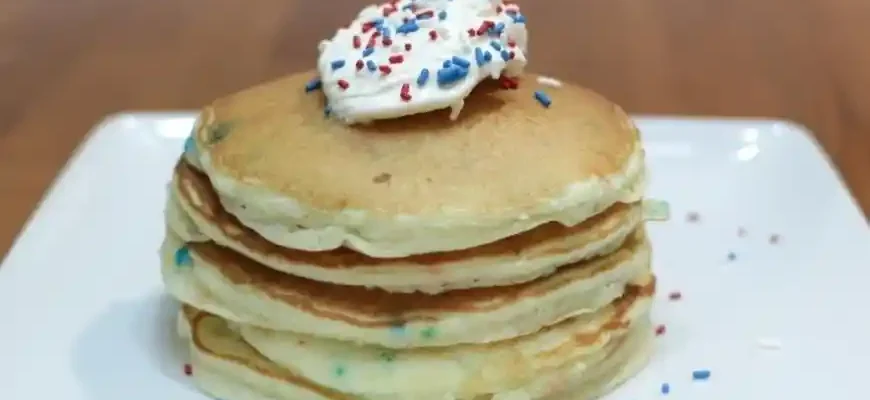Pancakes. The beloved comfort food. Whether it’s a lazy weekend morning, a cozy breakfast gathering, or just a treat on a Tuesday, pancakes have a way of bringing smiles to the table. But what happens when you decide to go vegan? The good news is that vegan pancakes are not only just as tasty as their traditional counterparts, but they can be even better. Lighter, fluffier, and guilt-free — when done right.
In this guide, I’m going to walk you through everything you need to know about making vegan pancakes, from the ingredients and techniques to the reasons why you might want to consider this plant-based alternative. And yes, I’ll cover some of the potential pitfalls along the way, so you can avoid them and make the best pancakes possible.
The Basics of Vegan Pancakes
First things first — what exactly is a vegan pancake? It’s a pancake made without any animal-based products, so there’s no milk, eggs, or butter. Instead, plant-based alternatives replace these ingredients, and the result is a pancake that’s delicious and cruelty-free.
Let’s break down the key ingredients:
- Flour
Regular all-purpose flour is usually your best bet, but you can experiment with whole wheat flour, oat flour, or even gluten-free flours like almond or rice flour. Keep in mind that using whole grain flours will make the pancakes denser, while all-purpose flour provides that light, fluffy texture we all love. If you’re gluten-free, use a gluten-free flour blend. - Plant Milk
Instead of dairy milk, you can use almond milk, oat milk, soy milk, or any other non-dairy milk you prefer. I personally love oat milk for its creaminess, but you can’t go wrong with a good almond or soy milk either. Just make sure your milk is unsweetened unless you want a sweeter pancake base. - Egg Substitute
Eggs provide structure and moisture to traditional pancakes, but there are plenty of egg replacements for your vegan pancakes. Common options include mashed bananas, flax eggs (1 tablespoon of ground flaxseeds mixed with 3 tablespoons of water), or even aquafaba (the liquid from canned chickpeas). If you want your pancakes extra fluffy, try adding a bit of baking powder or baking soda. - Sweeteners
In the vegan pancake world, sweeteners come in many forms. Maple syrup is the classic choice, but you can also use agave nectar, coconut sugar, or even a little vanilla extract to add sweetness to your batter. Some people even add a touch of cinnamon or nutmeg for a spiced kick. - Fats
In place of butter, you can use plant-based oils like coconut oil, olive oil, or vegetable oil. If you’re looking for something less oily, try using mashed avocado, which gives the pancakes a smooth, creamy texture. - Leavening Agents
You’ll need something to help your pancakes rise and fluff up. Baking powder is the most common choice here, although baking soda will also do the trick (just make sure to balance it out with an acidic ingredient like lemon juice or vinegar).
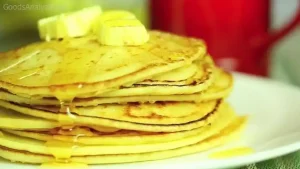
Step-by-Step Recipe for Perfect Vegan Pancakes
Now, let’s get to the actual pancake-making process. Grab your ingredients and let’s get cooking!
Ingredients:
- 1 cup all-purpose flour (or your preferred flour)
- 1 tablespoon sugar (optional)
- 2 tablespoons baking powder
- A pinch of salt
- 1 cup plant-based milk (oat, almond, or soy work great)
- 2 tablespoons vegetable oil (or melted coconut oil)
- 1 teaspoon vanilla extract
- 1 ripe banana (optional, but gives extra fluffiness and flavor)
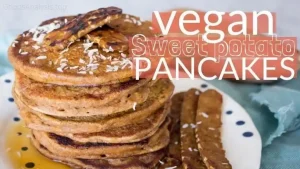
Instructions:
- Mix Dry Ingredients
In a large bowl, combine the flour, sugar, baking powder, and salt. Whisk them together to make sure the baking powder is evenly distributed. - Mix Wet Ingredients
In a separate bowl, whisk together the plant milk, oil, and vanilla extract. If you’re using a banana for extra moisture, mash it up and add it here. - Combine Wet and Dry Ingredients
Pour the wet ingredients into the dry ingredients and stir gently. The key here is to not over-mix; a few lumps are perfectly fine. Over-mixing can lead to tough pancakes. - Cook the Pancakes
Heat a non-stick skillet or griddle over medium heat and lightly grease it with a little oil or vegan butter. Pour about 1/4 cup of batter onto the skillet for each pancake. Let them cook for 2-3 minutes until small bubbles form on the surface, then flip and cook for another 2-3 minutes until golden brown. - Serve and Enjoy!
Serve your pancakes hot with your favorite toppings — maple syrup, fresh berries, banana slices, or a dollop of coconut yogurt. And don’t forget to sprinkle a little powdered sugar if you’re feeling extra indulgent.
Common Mistakes and How to Avoid Them
Making vegan pancakes isn’t hard, but there are a few mistakes that even experienced cooks can make. Here’s a rundown of the most common pitfalls and how to avoid them:
- Overmixing the Batter
It’s tempting to mix until everything is smooth, but doing so will lead to dense pancakes. Stir just until the dry ingredients are incorporated, and it’s okay if the batter is a little lumpy. - Not Using Enough Leavening Agent
Vegan pancakes need enough leavening (baking powder or soda) to get that fluffy texture. If your pancakes are coming out flat and dense, you might need to increase the amount of baking powder slightly. - Not Preheating the Pan Properly
If your pan isn’t hot enough, your pancakes will stick or cook unevenly. Make sure the skillet is properly preheated, and test it by dropping a small amount of water on the surface — it should sizzle. - Using the Wrong Flour
Not all flours are created equal. If you’re using a flour like almond flour or coconut flour, you’ll need to adjust the liquid because these flours absorb more moisture than all-purpose flour. - Too Much or Too Little Oil
Oil is key to getting a golden crust on your pancakes. Too little, and they’ll stick; too much, and they’ll be greasy. A light, even coating of oil on the pan works best.
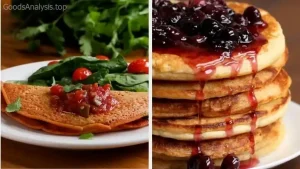
Health Benefits and Considerations
While vegan pancakes are undeniably delicious, they also come with health benefits that make them a great choice for anyone — whether you’re vegan or not.
- Lower in Cholesterol: Without eggs and dairy, vegan pancakes are free from cholesterol, which is a heart-health bonus for those trying to lower their risk of heart disease.
- More Fiber: Using whole grain flours like oats or whole wheat increases the fiber content, which is great for digestion and overall health.
- Lower Environmental Impact: Animal agriculture has a much larger environmental footprint than plant-based food production. By choosing vegan pancakes, you’re helping reduce carbon emissions and water usage.
Common Concerns and How to Address Them
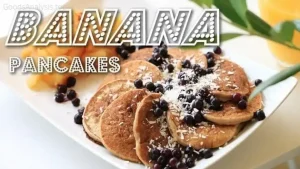
Some people might have concerns about vegan pancakes being less filling or not as satisfying as traditional pancakes. Here’s how to address those:
- Protein: If you’re worried about getting enough protein, you can easily add plant-based protein sources like chia seeds, hemp seeds, or protein powder to your pancake batter.
- Fluffiness: The key to fluffy pancakes is using enough leavening and not over-mixing. A vegan pancake can be just as fluffy as the traditional kind if done correctly.
Global Opinions on Vegan Pancakes
To add a little spice to this topic, let’s take a quick look at some opinions from people around the world:
- Emma, 34, UK: “I tried vegan pancakes because my friends kept talking about them. Honestly, I didn’t think they’d be any good, but wow, they were fluffy and delicious! The banana adds a nice sweetness, and I didn’t miss the eggs or milk at all.”
- Luis, 47, Mexico: “I’ve been eating plant-based for a while now, and making pancakes without eggs and dairy was a game-changer. They’re still rich, and I feel a lot better knowing they’re made with natural ingredients.”
- Aisha, 60, Nigeria: “My grandchildren love pancakes, so I’ve started making them vegan-style when they visit. They don’t notice the difference, and it’s great for their health. We top them with local fruits like pawpaw — so tasty!”
- Jack, 22, USA: “I switched to a vegan diet about six months ago, and pancakes were one of the first things I missed. Once I learned how easy it was to make vegan pancakes, I was hooked. Plus, they give me energy for my morning workouts.”
- Siti, 29, Indonesia: “Vegan pancakes are a recent addition to my breakfast routine, but I love them! I add a bit of coconut milk to the batter for extra richness. Definitely a healthier alternative to the regular ones.”
Final Thoughts
Making vegan pancakes is a rewarding experience. They’re simple to prepare, easy to customize, and full of benefits for both your health and the environment. Whether you’re vegan or just looking for a lighter, cruelty-free option, these pancakes can easily become your new go-to breakfast. So, gather your ingredients, get cooking, and enjoy a stack of pancakes that’s not only delicious but also kind to the planet.

